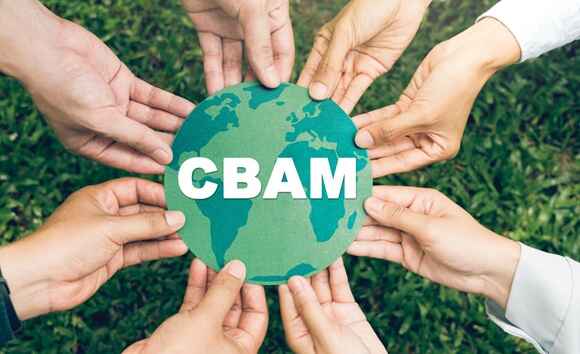Climate policies are changing global trade faster than anyone imagined. And at the centre of this shift is the Carbon Border Adjustment Mechanism (CBAM). It is the European Union’s move to price carbon in imports.
If an organisation exports goods to the EU, CBAM is something they cannot ignore. It is a rulebook that decides who gets to trade smoothly and ultimately who faces delays, penalties, or higher costs.
Here’s a simple guide to help you stay compliant.

What is CBAM?
CBAM levels the field between EU producers and exporters from other countries. It makes sure everyone pays fairly for the carbon embedded in their products.
For businesses, it’s more than just a compliance task. It’s access control.
Comply, and you can sell in the EU without interruption. Ignore it, and you stand on the verge of risking penalties or losing market access.
Further, complying early on signals positively to investors and buyers. It tells that your company takes climate responsibility seriously.
Why CBAM Matters for Businesses
CBAM levels the playing field between EU producers and exporters from other countries. It ensures that everyone pays fairly for the carbon embedded in their products.
For businesses, it’s more than just a compliance task. It’s access control. Comply, and you can sell in the EU without interruption. Ignore it, and you risk penalties or losing market access.
Plus, complying early signals to investors and buyers that your company takes climate responsibility seriously.
Step 1: Know If You’re Covered
Not every product falls under CBAM, at least not yet. The mechanism currently applies to imports of:
- Iron and steel
- Aluminium
- Cement
- Fertilisers
- Electricity
- Hydrogen
If an organisation deals with any of these, CBAM applies. Imports from Norway, Iceland, Liechtenstein, and Switzerland are exempt since they already follow the EU carbon pricing system.
Step 2: Register as an Authorised CBAM Declarant
Starting January 1, 2025, importers must apply to become Authorised CBAM Declarants. Only registered entities will be allowed to import CBAM-covered goods from January 1, 2026.
Registration is more than simply paperwork, it’s the legal gateway to keep trading.
Step 3: Report Your Embedded Emissions
From 2023 to 2025, CBAM is in its transitional phase. During this period, you must report the carbon emissions linked to your imports every quarter.
Reports must include:
- The quantity of imported goods
- Direct and indirect emissions from production
- Any carbon cost already paid in the country of origin
Reports are due at the end of the month following each quarter. Missing them can raise compliance risks later.
Step 4: Verify Your Data
Accuracy matters. Reports with actual data must be verified by an independent body. You can use one of two methods to calculate emissions:
- Calculation-based: Estimate emissions using activity data (like energy or material use) and apply standard emission factors.
- Measurement-based: Measure actual greenhouse gas concentrations at your production site. It is more precise, but also more complex.
Either way, your data must be traceable and consistent.
Step 5: Buy CBAM Certificates
From 2026 onward, CBAM enters its definitive regime. That’s when the real costs begin.
Importers must buy CBAM certificates equal to the amount of carbon embedded in their imports. The certificate price will mirror the average EU carbon price under the EU Emissions Trading System (ETS).
If your product has already paid a carbon price in its country of origin, that amount is deducted, no double charge.
Step 6: File the Annual CBAM Declaration
By May 31 every year, authorised declarants must file an annual CBAM declaration. It summarises total imports, embedded emissions, and certificates surrendered for the previous year.
If you fall short, meaning you didn’t buy enough certificates, expect penalties.
Step 7: Stay Updated on New Rules
The EU is refining CBAM constantly. The 2025 Simplification Package has already introduced new updates:
- 50-tonne exemption: Imports below this threshold are exempt but must still be tracked.
- Digital CBAM portal: A single online system for reports and certificates.
- New deadlines: Reports by 31 August, certificates by 31 October.
- Narrower emissions scope: Only direct emissions (including electricity use) are now covered.
In short: fewer excuses, faster reporting.
Step 8: Prepare for the Financial Impact
CBAM compliance will cost money. Certificates, verification, and data collection aren’t free.
Expect:
- Higher import costs for carbon-heavy goods.
- Supplier adjustments to meet EU data standards.
- Operational changes to track emissions across your value chain.
But there’s a silver lining. Businesses that decarbonise early can stay competitive and may even gain an edge as global carbon rules tighten.
Step 9: Integrate CBAM into ESG and Climate Strategy
CBAM isn’t a standalone requirement. It links closely with broader ESG and climate frameworks like the EU ETS, CSRD, and GHG Protocol.
Treat CBAM data as part of your ESG reporting. It helps maintain consistency across climate disclosures and builds credibility with investors. If you already report under ESG frameworks, you’re halfway there.
Final Thoughts
CBAM marks an importance in international trade. It is one where carbon is priced, tracked, and verified. For businesses, the smartest move is to act now. Build emission-tracking systems. Verify supplier data. Budget for certificates.
Complying with CBAM is more than just about staying legal, it’s about staying relevant. Because in the near future, the cleanest companies will be the most competitive ones.

